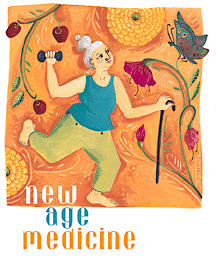

It only takes a quick look at America's projected demographics to see the wrinkles. In 1900, one in every 25 Americans was over 65. By 2050, it's estimated that one in five Americans will be over age 65. And those aged 85 and older are the most rapidly expanding elderly group, according to figures from the U.S. Census Bureau.
The effects of this population transformation pose challenges for all of society. Perhaps the most significant is the price to be paid, both in human and economic costs, for a poor quality of life resulting from illness that could have been prevented.
Keeping our aging population healthy and independent is a national priority. Yet this task is daunting. Results from the U.S. Surgeon General's 1996 Physical Activity and Health Report show some startling statistics:
* Less than 20 percent of Americans meet physical activity guidelines.
* By age 75, one in two women and one in three men engage in no physical activity.
How can such monumental health problems be addressed? By harnessing the power of prevention. While medical research offers ways to mend a damaged heart valve or fight an infection, prevention research focuses on keeping people free from disease and helping them lead healthier lives.
"The three leading causes of death--heart disease, cancer and stroke--are linked to modifiable risk factors: tobacco, poor diet/lack of exercise and alcohol," points out David Buchner, deputy director of the Northwest Prevention Effectiveness Center. "It's by changing these behaviors that we can make a real difference."
History shows that prevention does work. "Screening and treatment for eye disease among people with diabetes saves the federal government at least $248 million a year," reports the U.S. Centers for Disease Control. "For every $1 spent on school-based drug and alcohol, tobacco and sexuality education, $14 are saved in avoided health care costs."
One of the appealing aspects of preventive medicine for the elderly is its cost. The use of low-tech methods--hand weights, water exercises, nutrition guidelines, community meetings--illustrates the effectiveness of simplicity.
The UW center is a pioneer of prevention research and is the only federally funded center devoted to promoting health in men and women aged 65 and over. Established by the Centers for Disease Control in 1986, it is a collaborative program of the UW School of Public Health and Community Medicine and Group Health Cooperative of Puget Sound.
Reaching Out to Seniors Where They Live
Partners in Prevention
Staying Active: 11 Tips for the Elderly
Send a letter to the editor at columns@u.washington.edu.